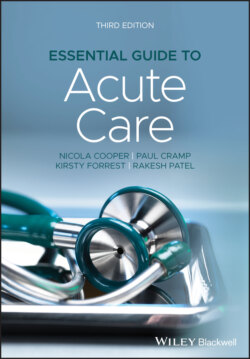Читать книгу Essential Guide to Acute Care - Nicola Cooper - Страница 18
Box 1.1 MET Calling Criteria
ОглавлениеAirway
If threatened
Breathing
All respiratory arrests
Respiratory rate <5/ min or >36/ min
Circulation
All cardiac arrests
Pulse rate <40/min or >140/min
Systolic blood pressure <90 mmHg
Neurology
Sudden fall in level of consciousness
Repeated or extended seizures
Other
Any patient you are seriously worried about that does not fit the above criteria
Source: Reproduced with permission by Prof Ken Hillman, University of New South Wales, Division of Critical Care, Liverpool Hospital, Sydney, Australia.
Table 1.1 UK National Early Warning Score (NEWS2).
Source: Reproduced with permission from Royal College of Physicians.12
| Physiological Parameter | 3 | 2 | 1 | 0 | 1 | 2 | 3 |
| Respiratory rate (per minute) | ≤8 | 9–11 | 12–20 | 21–24 | ≥25 | ||
| SpO2 Scale 1 (%) | ≤91 | 92–93 | 94–95 | ≥96 | |||
| SpO2 Scale 2 (%) | ≤83 | 84–85 | 86–87 | 88–92 ≥93 on air | 93–94 on oxygen | 95–96 on oxygen | ≥97 on oxygen |
| Air or oxygen? | Oxygen | Air | |||||
| Systolic blood pressure (mmHg) | ≤90 | 91–100 | 101–110 | 111–219 | ≥220 | ||
| Pulse (per minute) | ≤40 | 41–50 | 51–90 | 91–110 | 111–130 | ≥131 | |
| Consciousness | Alert | CVPU | |||||
| Temperature (°C) | ≤35.0 | 35.1–36.0 | 36.1–38.0 | 38.1–39.0 | ≥39.1 |
CVPU = confused, responds to voice, responds to pain, unresponsive.
Use SpO2 Scale 2 if target saturations are 88–92% under the direction of a qualified clinician.
Each observation has a score. The total score determines the potential clinical risk and what should happen next. Higher scores also mandate closer monitoring:
Total score 0–4: low risk, ward‐based response
Score 3 in any single parameter: low–medium risk, urgent ward‐based response
Total score 5–6: medium risk, urgent response by a team with competence in the assessment and management of acutely ill patients and in recognising when the escalation to a critical care team is appropriate
Total score 7 or more: high risk, urgent response by a team which must include staff with critical care skills, including airway management.
Table 1.2 UK severity of illness classification.
Source: Reproduced with permission from the Department of Health.15
| Level 0 | Patients whose needs can be met through normal ward care in an acute hospital |
| Level 1 | Patients at risk of their condition deteriorating, or those recently relocated from higher levels of care, whose needs can be met on an acute ward with additional advice and support from the critical care team |
| Level 2 | Patients requiring more detailed observation or intervention including support for a single failing organ system or post‐operative care and those stepping down from higher levels of care |
| Level 3 | Patients requiring advanced respiratory support alone or basic respiratory support together with support of at least two organ systems. This level includes all complex patients requiring support for multi‐organ failure |
Level 2 is equivalent to HDU care.
Level 3 is equivalent to ICU care.
Early experience in the UK suggested that medical emergency teams instead of cardiac arrest teams reduced ICU mortality and the number of cardiac arrests, partly through an increase in ‘do not attempt CPR’ orders.11 In 1999, the report ‘Critical to Success – the place of efficient and effective critical care services within the acute hospital’14 re‐emphasised the concept of the patient at risk, advocating for better training of medical and nursing staff and ‘outreach’ critical care. The report commented that intensive care is something that tends to happen within four walls, but that patients should not be defined by what bed they occupy, but by their severity of illness (see Table 1.2).
Following this, ‘Comprehensive Critical Care – a review of adult critical care services’15 was published and reiterated the idea that patients should be classified according to their severity of illness and the necessary resources mobilised. With this report came funding for critical care outreach teams and an expansion in critical care beds. In the USA and parts of Europe, there is considerable provision of level 1 and 2 facilities. In most UK hospitals it is recognised that there are not enough16,17 even with the 10% increase in critical care beds that has taken place in England between 2011 and 2018.18
Although there are many different variations of early warning scores in use, it is probably the recognition of abnormal physiology, however measured, and a protocol that requires inexperienced staff to call for help that makes a difference, rather than the score itself. Patients at particular risk are recent emergency admissions, after major surgery, and following discharge from intensive care.
